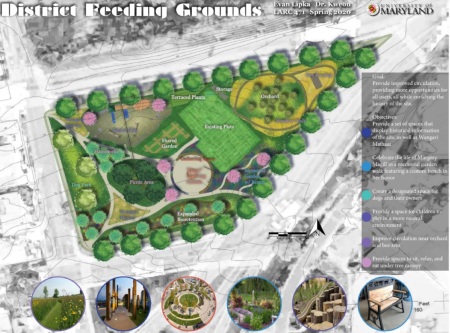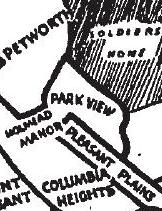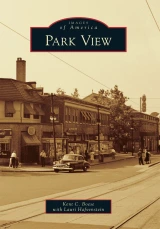On Sunday, April 6th, DC Water was at Wangari Gardens as part of an event that included a Gardening Orientation Session, Composting Cooperatve, Applications for Garden Plots, and a Bioretention Area Presentation. There were also free Dogwood seedlings to the first 50 guests.

Looking north from Michigan Avenue toward the Wangari Gardens. Unfinished bioretention area in the foreground.
The bioretention areas are part of medium-term Bloomingdale flood mitigation efforts DC Water has undertaken to reduce stormwater runoff. I’ve been keenly interested in these area and stopped by on Sunday to take a look at the progress. I’m happy to report that DC Water has done an excellent job with the areas closest to Wangari, and the areas to the south are well underway.
The purpose of this project, according to DC Water, is to capture, infiltrate, and treat stormwater runoff before it enters the sewer system. The project includes 15 bioretention areas (similar to rain gardens) along the Irving Street corridor between Michigan Avenue and North Capitol Street, including the Wangari Gardens site.
The the primary purpose of these bioretention areas is to prevent flooding, bioretention areas are planted filter beds of specialized soil, sand, and stone aggregate. The areas are typically slightly depressed into the surrounding landscape to facilitate runoff flow to the system. Bioretention is used to slow, cool, filter, and infiltrate stormwater runoff, and can be used to reduce flooding associated with stormwater. The bioretention plantings and soil remove contaminants and excess nutrients from stormwater.
 (The bioretention area along Park Place just south of Irving.)
(The bioretention area along Park Place just south of Irving.)
What I particularly like is that these areas have the additional benefits
of habitat creation, urban heat island reduction, green space enhancement, and air quality improvements. In walking around Wangari and assessing what DC Water has created, I could easily see how the bioretention areas will add beauty to the areas.
Below is the plan as implemented on the western edge of Wangari Gardens, along Park Place. In reviewing the plan, notice that a variety of trees and plantings were part of the project which will help make the area both beautiful and useful. (Image courtesy of DC Water)
(Image courtesy of DC Water)















 "The territory comprising Park View extends from Gresham Street north to Rock Creek Church Road, and from Georgia Avenue to the Soldiers' Home grounds, including the triangle bounded by Park Road, Georgia Avenue, and New Hampshire Avenue" (from Directory and History of Park View, 1921.)
"The territory comprising Park View extends from Gresham Street north to Rock Creek Church Road, and from Georgia Avenue to the Soldiers' Home grounds, including the triangle bounded by Park Road, Georgia Avenue, and New Hampshire Avenue" (from Directory and History of Park View, 1921.)
